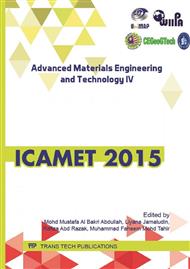[1]
Tummala, R.R., 2001. Fundamentals of Microsystems Packaging, McGraw-Hill, New York, pp.311-312.
Google Scholar
[2]
Zulkifli, M.N., Abdullah, S., Othman, N.K., Jalar, A., 2012. Some thoughts on bondability and strength of gold wire bonding. Gold Bull. 45, 115-125.
DOI: 10.1007/s13404-012-0060-y
Google Scholar
[3]
Zhong, Z.W., 2009. Fine and ultra-fine pitch wire bonding: challenges and solutions. Microelectron. Int. 26, 10-18.
DOI: 10.1108/13565360910960187
Google Scholar
[4]
Qi, J., Hung, N.C., Li, M., Liu, D., 2006. Effects of process parameters on bondability in ultrasonic ball bonding. Scripta Mater. 52, 293-297.
DOI: 10.1016/j.scriptamat.2005.07.042
Google Scholar
[5]
Lum, I., Jung, J.P., Zhou, Y., 2005. Bonding Mechanism in Ultrasonic Gold Ball Bonds on Copper Substrate. Metall. Mater. Trans. A. 36A, 1279-1286.
DOI: 10.1007/s11661-005-0220-2
Google Scholar
[6]
Saiki, H., Marumo, Y., Nishitake, H., Uemura, T., Yotsumoto, T., 2006. Deformation analysis of Au wire bonding. J. Mater. Process. Tech. 177, 709-712.
DOI: 10.1016/j.jmatprotec.2006.04.024
Google Scholar
[7]
An, B., Ding, L., Wang, T., Lu, T., Sun, L., Wu, Y., 2011. Improvement of the second bond strength in copper wire bonding on pre-plated leadframe, IEEE 12th International Conference on Electronic Packaging Technology and High Density Packaging (ICEPT-HDP), Shanghai, p.1.
DOI: 10.1109/icept.2011.6066860
Google Scholar
[8]
Shah, A., Mayer, M., Zhou, Y., Hong, S.J., Moon, J.T., 2008. In situ ultrasonic force signal during low-temperature thermosonic copper wire bonding. Micron. Eng. 85, 851-1857.
DOI: 10.1016/j.mee.2008.05.035
Google Scholar
[9]
Qin, I., Shah, A., Huynh, C., DeAngelis, D., Meyer, M., Mayer, M., Zhou, Y., 2010. Thermosonic Au Ball Bonding Process Investigated using Microsensor and Laser Vibrometer, IEEE 2010 Proceeding 60th Eelectronic Components and Technology Conference (ECTC), Las Vegas, pp.1776-1782.
DOI: 10.1109/ectc.2010.5490729
Google Scholar
[10]
Zhong, Z.W., Goh, K.S., 2006. Investigation of ultrasonic vibrations of wire-bonding capillaries. Microelectr. J. 37, 107-113.
DOI: 10.1016/j.mejo.2005.04.045
Google Scholar
[11]
Li, J., Han, L., Duan, J., Zhong, J., 2007. Microstructural characteristics of Au/Al bonded interfaces. Mater. Charact. 58, 103-107.
DOI: 10.1016/j.matchar.2006.03.018
Google Scholar
[12]
Hibbeler, R.C., 1997. Engineering Mechanics: Dynamics, Prentice Hall, New Jersey, pp.150-151.
Google Scholar


